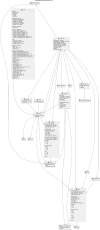This is a preprint.
Nanoscale Connectomics Annotation Standards Framework
- PMID: 39575115
- PMCID: PMC11581105
Nanoscale Connectomics Annotation Standards Framework
Abstract
The promise of large-scale, high-resolution datasets from Electron Microscopy (EM) and X-ray Microtomography (XRM) lies in their ability to reveal neural structures and synaptic connectivity, which is critical for understanding the brain. Effectively managing these complex and rapidly increasing datasets will enable new scientific insights, facilitate querying, and support secondary use across the neuroscience community. However, without effective neurodata standards that permit use of these data across multiple systems and workflows, these valuable and costly datasets risk being underutilized especially as they surpass petascale levels. These standards will promote data sharing through accessible interfaces, allow researchers to build on each other's work, and guide the development of tools and capabilities that are interoperable. Herein we outline a standards framework for creating and managing annotations originating and derived from high-resolution volumetric imaging and connectomic datasets, focusing on ensuring Findable, Accessible, Interoperable, and Reusable (FAIR) practices. The goal is to enhance collaborative efforts, boost the reliability of findings, and enable comparative analysis across growing datasets of different species and modalities. We have formed a global working group with academic and industry partners in the high-resolution volumetric data generation and analysis community, focused on identifying gaps in current EM and XRM data pipelines, and refining outlines and platforms for standardizing EM and XRM methods. This focus considers existing and past community approaches and includes examining neuronal entities, biological components, and associated metadata, while emphasizing adaptability and fostering collaboration.
Keywords: Connectomics; Data Standards; Electron Microscopy; FAIR Data; Neuroanatomy; X-ray Microtomography.
Figures




References
-
- Briggman K. L., Helmstaedter M., and Denk W., “Wiring specificity in the direction-selectivity circuit of the retina,” Nature, vol. 471, no. 7337, pp. 183–188, 2011. - PubMed
-
- Macpherson T., Churchland A., Sejnowski T., DiCarlo J., Kamitani Y., Takahashi H., and Hikida T., “Natural and artificial intelligence: A brief introduction to the interplay between ai and neuroscience research,” Neural Networks, vol. 144, pp. 603–613, 2021. - PubMed
Publication types
Grants and funding
LinkOut - more resources
Full Text Sources
Miscellaneous
